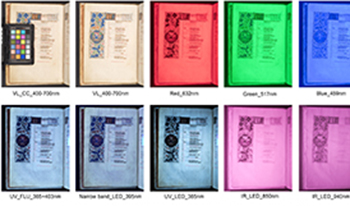
Multispectral imaging has become an essential tool for the analysis, documentation, and visualization of cultural heritage materials and objects. This study explores the application of this technique to a 15th-century illuminated manuscript held at the Brazilian National Library (Fundação Biblioteca Nacional) in Rio de Janeiro. The manuscript, currently part of ongoing doctoral research, contains erased text due to censorship through scraping. The use of multispectral imaging, incorporating eleven different wavelengths across UV, visible, and IR spectra, proved highly effective in recovering the erased words "pape" and "thoma", thus confirming the hypothesis of scholar Damião Berge regarding the lacunae and linking the codex to a 16th-century historical event.

Computer Vision has become increasingly important in smart farming applications, including scheduling crop irrigation. A combination of various remote sensing devices enables continuous monitoring of a crop and non-destructive prediction of irrigation time. Appropriately scheduled and precisely targeted irrigation enables sustainable use of this limited resource. In agriculture, absorption-based and thermal-based imagery are used to monitor plant conditions through indices such as the Normalized Difference Water Index (NDWI) and Crop Water Stress Index (CWSI). This paper provides an overview of the concept and components of monitoring systems for automated irrigation scheduling. It explains the potential and limitations of applying computer vision-based systems for plant stress detection, providing insights to advance understanding in this growing field.

The ARMID@Venezia project aims to safeguard extraordinary collections, both handwritten and printed, preserved in the library of the Benedetto Marcello Conservatory of Venice, heavily damaged by the exceptionally high tide of November, 2019. The project was moreover conceived to integrate various competencies from art history, conservation science, archival systems, and music philology, in order to propose a comprehensive and innovative perception on the conservation of documents. The project involves digitalization (through high-resolution photographic reproduction), virtual restoration and a detailed investigation of the materials used (supports, inks, pigments, dyes, etc.) for future physical restoration. Only non-invasive and non-destructive techniques are being employed, such as imaging analysis in the visible (including macro- and micro-photographic examination), near infrared (NIR), and near ultraviolet (UV-induced fluorescence or UVF, and reflected UV or UVR) range, on representative artefacts. In addition, non-invasive spectroscopic techniques, such as Fiber Optics Reflectance Spectroscopy (FORS), μ-Raman and X-Ray (XRF) were also applied for a detailed chemical characterization of materials used to support the results obtained through imaging analyses. In this article, the results of multispectral imaging (MSI) conducted in three different categories of music sources, paper manuscripts, parchment manuscripts, and printed books, are discussed and compared with spectroscopic techniques, confirming the benefits of photographic investigation in these artworks. The great assortment of available documents, in terms of constitutive materials, historical period of production and state of conservation, is a strong point of this project in order to test the potential holistic approach to safeguard the documents collected in the library.
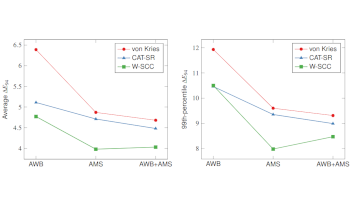
This paper presents a novel approach for spectral illuminant correction in smartphone imaging systems, aiming to improve color accuracy and enhance image quality. The methods introduced include Spectral Super Resolution and Weighted Spectral Color Correction (W-SCC). These techniques leverage the spectral information of both the image and the illuminant to perform effective color correction. Experimental evaluations were conducted using a dataset of 100 synthetic images, whose acquisition is simulated using the transmittance information of a Huawei P50 smartphone camera sensor and an Ambient light Multispectral Sensor (AMS). The results demonstrate the superiority of the proposed methods compared to traditional trichromatic pipelines, achieving significant reductions in colorimetric errors measured in terms of ΔE94 units. The W-SCC technique, in particular, incorporates per-wavelength weight optimization, further enhancing the accuracy of spectral illuminant correction. The presented approaches have valuable applications in various fields, including color analysis, computer vision, and image processing. Future research directions may involve exploring additional optimization techniques and incorporating advanced machine learning algorithms to further advance spectral illuminant correction in smartphone imaging systems.
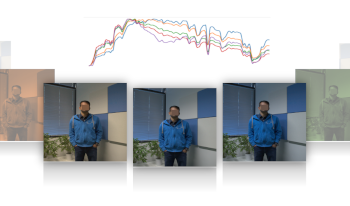
A pipeline for the generation of synthetic dataset of spectral scenes, with corresponding sensor readings, is here proposed. The pipeline is composed of two main parts: Part 1: Image pixel reflectance assignment. Individual pixels from an input sRGB image dataset are replaced with appropriate reflectance spectra from a given non-image reflectance dataset. The resulting dataset of reflectance images is considered the starting point for simulated sensor acquisition. Part 2: Simulated sensor acquisition. Each spectral reflectance image in the dataset is illuminated with an illuminant spectra to produce a radiance image. The resulting dataset of radiance images is then synthetically read from the simulated sensors (camera and ambient multispectral sensor) of the Huawei P50 phone, using the corresponding sensors transmittance information. The capability of generating any large-scale, diverse, and annotated synthetic spectral datasets can facilitate the development of data-driven imaging algorithms, and foster reproducible research.
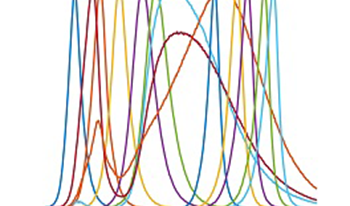
In this study, a multispectral imaging system with an RGB camera and a multichannel LED system was investigated. Firstly, it was proposed to generalize a previous method to optimize the flexible combinations of no more than three LED channels in each light source. The systems of 6-channel, 9-channel, and 12-channel were obtained, and their performances were compared with a typical 3-channel system under D65. Subsequently, the systems using single LED channels as light sources were explored. Two different methods (single-light and single-channel) were developed by selecting different numbers of the optimal lights or system channels. It was found the single-channel system outperformed the system using combined LED channels in terms of the spectral reconstruction accuracy. However, it should be noted the single-channel system required significantly more captures than the method by combining three channels in a light.

The dynamic range that can be captured using traditional image capture devices is limited by their design. While an image sensor cannot capture the entire dynamic range in one exposure that the human eye can see, imaging techniques have been developed to help accomplish this. By incorporating high dynamic range imaging, the range of contrast captured is also increased, helping to improve color accuracy. Cultural heritage institutions face limitations when trying to capture color accurate reproductions of cultural heritage objects and materials. To mitigate this, a team of software engineers at RIT have developed a software application, BeyondRGB, to enable the colorimetric and spectral processing of six-channel spectral images. This work aims to incorporate high dynamic range imaging into the BeyondRGB computational pipeline to improve color accuracy further.
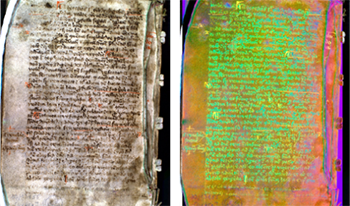
Some cultural heritage collections such as manuscripts, scrolls, books, sheet and folia that are faded, damaged, or otherwise unreadable present challenges for curators, collections professionals, scholars, and researchers looking to understand collections more fully. Seeking to uncover distinct features of objects, they have employed modern imaging tools, including sensors, lenses, and illumination sources and thus positioned multispectral imaging as a critical method for cultural heritage imaging. However, cost and ease-of-use have been prohibiting factors. To address this, Rochester Institute of Technology received a grant from the National Endowment for the Humanities (PR-268783-20) to fund an interdisciplinary collaboration to develop a low-cost, portable imaging system with processing software that could be utilized by scholars accessing collections in library, archive, and museum settings, as well as staff working within these institutions. This article addresses our open source and extensible software applications, from the first iteration of software in 2020 to our current effort in 2022-23 which seeks to simplify both processes. An overview of the image capture and processing software to capture and visualize the spectral data offers a basis for demonstrating the possibilities for low-cost, low barrier-to-entry software on cultural heritage imaging, research, preservation, and dissemination.
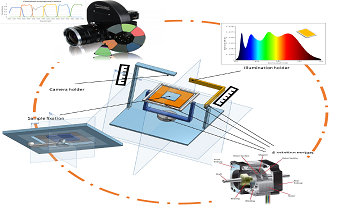
This paper introduces a novel system for measuring the appearance of materials by capturing their reflectance represented by Spatially Varying Bidirectional Reflectance Distribution Function (SVBRDF) and Bidirectional Texture Function (BTF). Inspired by goniospectrophotometers, our system uses a fully-aligned and motorized turntable that rotates the sample around three axes to scan the entire hemispherical range of incident-reflection directions. The camera remains fixed while the light source can be rotated around one axis providing the fourth degree of freedom. To ensure high precision color measurement and spectral reproduction for reliable relighting purposes, we use a high-resolution multispectral camera and a broadband LED light source. We provide an overview of our instrument in this paper, and discuss its limitations to be addressed in the future works.
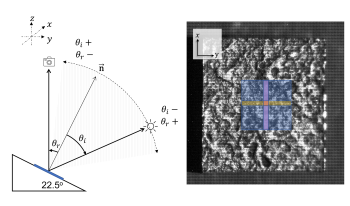
Materials with special appearance properties such as goniochromatic materials require complex bidirectional measurements to properly characterise their colour and gloss. Normally, these measurements are performed by goniospectrophotometers which are expensive and not commonly available. In this paper a flexible imaging system composed of a snapshot multispectral camera and a light source attached to a robotic arm, is used to obtain HDR BRDF measurements of patinas commonly used in cultural heritage objects. The system is evaluated by comparing the results to those of a commercially available goniospectrophotometer. It is found that with a known uncertainty, the system is capable of producing accurate measurements of samples with a roughness equal or lower than 6.19 μm. For roughnesses higher that 12.48 μm, the accuracy of the system decreases. Moreover, it is found that the size and orientation of the region of interest plays a great influence on the precision of the imaging system.